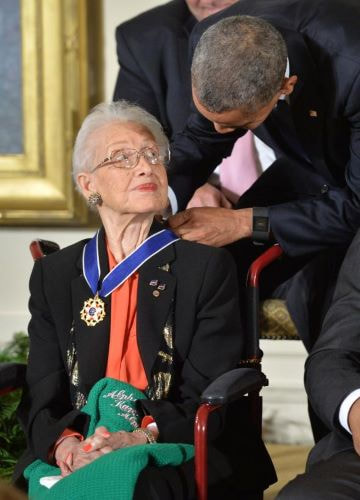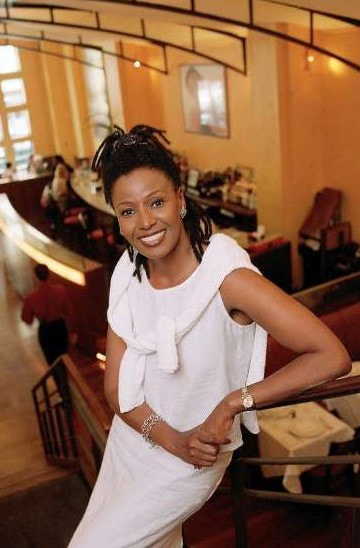|
It's Black History Month in the U.S. -- time to acknowledge people who have succeeded despite the shackles of slavery and segregation -- America's original sin, still hanging over us.
By sad coincidence, two of America's great strivers passed within days of each other, and have been honored in lavish and literate obituaries by two star writers in The New York Times. Katherine Johnson and B. Smith both had singular success in demanding fields, breaking barriers and stereotypes. Mrs. Johnson escaped segregated schools to qualify as a mathematician for NASA, and later made the pre-computer calculations that helped take American astronauts into space. (My Appalachian buddy, Randolph Fiery, points out in a Comment below just how difficult it was for Mrs. Johnson's parents to seek a high level of education for their precocious daughter, involving a long trek over the mountains of West Virginia.) Katherine Johnson and her black female colleagues were later depicted in the movie “Hidden Figures.” She died at 101 on Monday in Virginia and was honored in an obituary by Margalit Fox. “NASA was a very professional organization,” the obituary quoted Mrs. Johnson telling The Observer of Fayetteville, N.C., in 2010. “They didn’t have time to be concerned about what color I was.” B. Smith began as a model, wrote and was a television host and designed household goods, but was best known for the restaurant bearing her name in the Theater District of Manhattan. She died at 70 on Saturday on Long Island. The obituary by William Grimes told how Barbara Smith from Pennsylvania was a dynamo in childhood: “I inherited a paper route, I sold magazines, had lemonade stands, I was a candy striper and into fund-raising,” she told The Times in 2011. “I’ve always enjoyed being busy.” She had her self-image, and she was not shy about describing it: “B. Smith’s brand is about is bringing people together," she said, speaking of herself in the third person, as basketball superstars do on occasion. "I think that if Martha Stewart and Oprah had a daughter, it would be B. Smith,” she told National Public Radio in 2007. The success and resolve of Katherine Johnson and B. Smith, as they ignored stereotypes, would be inspiring anytime. In Black History Month, the accounts of their accomplished lives lit up my day. * * * (The obits are too long to reproduce here, so I am enclosing the links to the NYT website. People who do not subscribe can pull up a certain amount of free links per month. Other obits of these two achievers will surely be on the web -- GV.) Katherine Johnson: https://www.nytimes.com/2020/02/24/science/katherine-johnson-dead.html?action=click&module=Top%20Stories&pgtype=Homepage B. Smith: https://www.nytimes.com/2020/02/23/obituaries/b-smith-dead.html?searchResultPosition=1
bruce
2/25/2020 01:40:40 am
george,
George Vecsey
2/25/2020 08:55:24 am
Bruce: Not hard to believe at all. My friend Al from high school can recall being steered to "general" classes and he had to persevere to get into college prep courses: Advanced degrees, career in a government agency, good life, but had to lobby hard against the system.
bruce
2/25/2020 09:43:59 am
george,
George Vecsey
2/25/2020 10:00:30 am
Bruce: I can think of two that are "in the can."
bruce
2/25/2020 10:03:42 am
george,
Randolph
2/25/2020 08:13:55 am
George,
George Vecsey
2/25/2020 09:00:26 am
Randy: thanks, man. Takes an Appalachian person to put this in perspective.I know how long it would take to go 125 miles across the hills in the 70's when I was roaming that territory -- roads all chewed up by coal trucks that took their half out of the middle. The psychic distance was massive, also -- a daughter with obvious skills, and a black school 125 miles away. Or think of those children walking into Little Rock Central, or hundreds of other schools. Thanks for the comment. GV
Hank Ratner
2/25/2020 12:52:38 pm
George,
George
2/25/2020 01:12:27 pm
Hank: I only knew her from her radio commercials, so lucid and low-key, and the occasional photo, beautiful and centered person. My friend was at the restaurant 7-8 years ago and she had just wandered off....the Alzheimer's was moving fast. They located her down the block somewhere. Horrible to imagine somebody that vital, gone so young. Best, GV 2/25/2020 06:16:21 pm
Thanks for giving Kathrine Johnson and B. Smith a well-deserved George Vecsey Review. Comments are closed.
|
Categories
All
|











